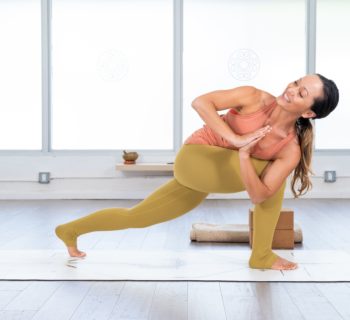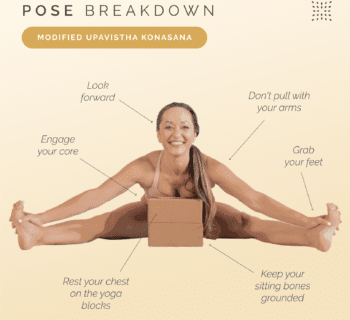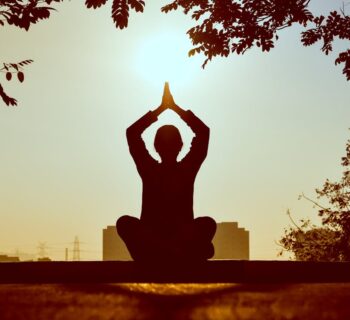Feeling stiff and disconnected from your own body can be a frustrating experience, can’t it?
That’s where the ancient art of yoga shines. As you step onto a mat for the first time, there’s a sense of beginning a journey—an unfolding that delicately bridges the gap between mind and body. And soon, you discover that yoga isn’t simply about stretching; it’s about cultivating a deeper understanding of oneself, finding strength within softness, and unlocking a well of vitality that you never knew you had.
Unlocking Yoga Benefits for Health
Engaging in a beginners’ yoga practice can dramatically enhance your overall wellness. By starting with easy poses, you’ll bolster physical agility, relieve stress, elevate your mental clarity, and tap into a rejuvenating sense of serenity that can transform your daily life experience.
Regular yoga sessions contribute to increased flexibility, supporting your joints and maintaining a healthy range of motion. Embrace this timeless practice, and your body will thank you for the profound impact on your physiological vitality.
Boosting Overall Flexibility
Flexibility is a cornerstone of yoga—accessible to all—and a vital aspect of lifelong wellness and mobility.
Regular yoga practice can increase flexibility, reducing risk of injuries and enhancing movement efficiency.
By including gentle poses in your routine, gradually extending your reach and deepening stretches, you nurture suppleness in your muscles, fostering resilient and adaptable tissues.
Achieving greater flexibility isn’t instantaneous—it’s a journey, a testament to patience and consistent practice, which incrementally awards you with a deeper range of motion and refined physical harmony.
Enhancing Muscular Strength
Strength is a core pillar of yoga practice.
Through a variety of weight-bearing poses, yoga helps build muscle strength in a balanced manner. Poses like Plank, Chaturanga, and Warrior series require you to support your own body weight, which helps develop lean muscle mass. Fortifying these muscles can aid in improving your posture, reducing the risk of injury, and providing a solid foundation for more advanced yoga poses.
Sculpt your body with mindful alignment and breath.
While yoga tones muscles, it also promotes mental focus – a synergy of mind and muscle. As you engage in practices like sun salutations or chair pose, be conscious of your breath. This focus enhances your control and the effectiveness of each pose while strengthening muscles gradually and sustainably.
Experience the strength that comes from within.
With dedicated practice and patience, beginners will witness their muscular strength bloom. Yoga’s progressive nature means everyone starts at their own level, but with time, consistency, and the guidance of experienced instructors, the boundaries of strength and stamina are expanded. Imagine the satisfaction as poses that once seemed insurmountable become part of your regular routine.
Starting Your Yoga Journey
Embarking on the path of yoga is akin to opening a door to improved health and profound self-discovery. As beginners, there’s a world of simple poses and practices that await to enhance your flexibility, strength, and mental clarity. Rest assured, starting this journey requires no special equipment or prior experience—just a willingness to explore the capabilities of your own body and mind.
As you step onto the mat for the first time, adopt what’s known as a “beginner’s mind”: an attitude of openness and eagerness to learn without preconceptions. This approach allows you to experience each posture as a unique exploration of movement and breath. Pay close attention to your body’s signals, respect its limits, and be patient with your progress. The transformation won’t happen overnight, but each session will bring you closer to a more balanced, stronger self.
Selecting the Right Environment
Finding the ideal space for your yoga practice enhances your experience and deepens your connection.
Calm and Comfortable: Seek an area that is quiet and soothing, free from distractions or interruptions.
Space Matters: Ensure you have sufficient room to move and stretch without constraints.
Nature’s Touch: If possible, practice near natural light or in an environment with a view of greenery.
Personalize: Infuse the area with elements that inspire tranquility, such as candles, incense, or calming colors.
Consistency is Key: Try to establish a dedicated space for practice to build a routine and generate positive energy.
A conducive environment supports your focus and allows your practice to flourish.
Subtle details in your practice space can significantly influence your physical and mental comfort.
Choosing Appropriate Gear
Selecting the right yoga mat provides stability and cushioning for your practice, ensuring comfort and reducing the risk of injury.
Invest in comfortable, breathable clothing that won’t restrict your movements.
A high-quality yoga block can assist in poses, ensuring proper alignment and support for your body.
Choose a durable yoga strap to help extend your reach and maintain poses, fostering flexibility over time.
Consider the thickness of your yoga mat; if you have sensitive knees, a thicker mat may provide extra cushioning and support during kneeling poses.
Lastly, ensure your gear aligns with your values; eco-friendly options are available that balance performance with sustainability.
Fundamental Yoga Poses Explained
Embarking on your yoga journey begins with mastering foundational poses. These asanas lay the groundwork for building strength and enhancing flexibility. Start with the Mountain Pose (Tadasana), which might seem simple but establishes the principle of alignment and grounding. Downward-Facing Dog (Adho Mukha Svanasana) then elongates the spine and opens the shoulders, setting a basis for inversions. These, along with the other beginner yoga poses listed below, are ideal to get you started on your yoga journey.
Mastering the Mountain Pose
Mountain Pose (Tadasana) is deceptively simple, yet it’s the foundation on which true postural integrity is built. In its essence, Tadasana fosters a connection to the earth, a moment where you establish your base and cultivate a sense of grounding and centeredness.
In practice, to perform Tadasana, stand with your feet hip-width apart and distribute your weight evenly across the soles of your feet. Align your knees, hips, and shoulders, and let your arms hang naturally with palms facing forward. As you engage the core, imagine a straight line extending upwards from the crown of your head, elongating your spine while maintaining a neutral pelvis. This active engagement is what elevates Mountain Pose from a simple standing position to a transformative experience that refines body awareness and poise.
Remember, Mountain Pose is an opportunity to reset and recalibrate your posture. By regularly incorporating this asana into your practice, you anchor your focus into the present, nurturing stillness and stability that will permeate other areas of your life. It’s also an excellent precursor to more advanced standing postures, serving as a reminder to maintain structural integrity and balance as your practice evolves.
Ultimately, the mastery of Mountain Pose is a journey of incremental improvement, particularly for beginners. Be patient and allow your alignment to refine over time. This posture serves as both a grounding force and a reflective space, reminding you to stand tall and strong in your practice and in life. As you progress, other asanas will unfold with greater ease, demonstrating the profound significance of Tadasana as a foundation for both physical and mental resilience in the ever-expanding world of yoga.

Embracing the Downward Dog
The Downward Dog pose is a foundational element of yoga, enhancing flexibility, strength, and tranquility.
Begin on your hands and knees, aligning wrists under shoulders and knees under hips.
Exhale and lift your hips, straightening your legs to form an inverted V-shape.
Press firmly through your palms, extending your spine, and tuck your chin slightly.
Engage your core and quads, distributing weight evenly between hands and feet.
Hold the pose for a few breaths, feeling a deep stretch in your hamstrings and calves.
On an exhale, gently lower back into a starting position or transition to another pose.
Patience and consistency are key; aim for a lengthened spine over perfectly straight legs.
In time, Downward Dog will fortify your body, providing a robust framework for a diverse yoga repertoire.
Other Poses
Other good poses to learn as a beginner are Triangle Pose (Trikonasana), Tree Pose (Vrksasana), Warrior II (Virabhadrasana II), Child’s Pose (Balasana), Easy Pose (Sukhasana), Bridge Pose, Cobra Pose, and Corpse Pose.
Cultivating a Consistent Practice
Embarking on a yoga journey requires not just intent but also a commitment to regular practice. As a beginner, aim to integrate yoga into your daily routine, carving out a specific time and space that signals to your body and mind, “It’s time for yoga.” Establishing this ritual fosters discipline, and over time, your dedication will translate into enhanced flexibility, strengthened muscles, and a more serene outlook on life. Remember, consistency is more transformative than intensity; a few minutes each day can yield more profound benefits than a sporadic, all-out session. Embrace the gradual unfolding of your practice, and let your progress be a testament to the power of steady, mindful repetition.
Setting Achievable Goals
Before unfurling your yoga mat, pinpoint precise, manageable objectives to guide your practice.
Start with consistency over intensity: commit to a frequency that fits your schedule.
Establish time-bound targets, like mastering a specific pose in three weeks.
Focus on incremental progression; celebrate small advancements in flexibility and strength.
Set realistic expectations, understanding that flexibility and skill develop over time.
Ambitious goals are admirable, but they must be sculpted into attainable milestones.
Embrace the journey of yoga as one of gradual improvement, where every stretch and pose builds the path to a stronger, more flexible you.
Integrating Yoga into Daily Life
Incorporate yoga into your morning routine to start the day with balance and intention.
Yoga’s adaptability allows it to blend seamlessly into any lifestyle.
By dedicating just a few minutes to mindful stretching each evening, you can create a ritual that fosters relaxation and prepares the body for restful sleep.
Establishing a daily practice, even if brief, can significantly enhance your well-being. Embedding simple poses into your routines, whether through morning sun salutations or breathing exercises during work breaks, cultivates a resilient foundation for physical health and mental clarity. It’s about making yoga accessible and approachable, not an added pressure or insurmountable challenge.
Photo by Jared Rice on Unsplash








